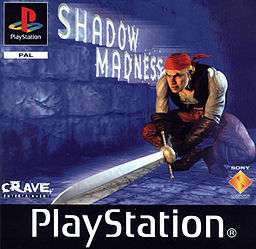Shadow Madness
| Shadow Madness | |
|---|---|
 | |
| Developer(s) | Craveyard Studios |
| Publisher(s) | Crave Entertainment |
| Producer(s) | Ted Woolsey |
| Designer(s) | Paul Reed |
| Artist(s) | Annabella Serra |
| Platform(s) | PlayStation |
| Release date(s) | |
| Genre(s) | Tactical role-playing |
| Mode(s) | Single-player |
Shadow Madness is a turn-based tactical role-playing video game, the first video game developed by Crave Entertainment. The game achieved mixed reviews. Shadow Madness was packaged with a separate demo disc for Jade Cocoon.[1]
Gameplay
The player's party consists of three members, each with their own strengths and weaknesses. In battle, the player has a choice of using physical attacks, magic, items and escape. It plays the same on the field in terms of using inventory, moving about and talking to non-player characters.
Battles in Shadow Madness are random, but one unique aspect of this system lets players avoid some battles. When exploring, the growl of a monster is heard. Pressing L2 and R2 simultaneously will make Stinger "hide" on the ground and doing this allows the player to possibly avoid a battle altogether. Shadow Madness uses some elements of Square's Active-Time Battle system. In particular, enemies will not wait to attack. The maximum level of experience a character can reach is 15. Characters can unleash powerful "summons" during battle.
Shadow Madness features 3D polygonal models on 2D pre-rendered backgrounds, with the battle scenes taking place in a fully 3D environment. The game includes CG cutscenes to further the storyline.
Plot
Story
The storyline is centered on saving the world from a mysterious plague that is spreading quickly. The player takes the role as Stinger, whose town has just been destroyed. The player meets many friends and foes on their way to finding out how the chaos started and how it can be stopped.
Characters
- Stinger — When the chaos wipes out his hometown, he vows to end the chaos.
- Windleaf — Joins Stinger after her secluded sylvan village gets attacked.
- Harv-5 — Robot originally created for harvesting crops, but when the demons destroy his fields and home he sets out to find out his purpose. His catchphrase of sorts is "There will be death."
- Xero Von Moon — Mage Warrior who has been resurrected from his deep sleep, he has no body so floats around with just his head.
- Clemett — He is a native Gadgeteer, but he didn't agree with how they lived so went to live with humans, and when the chaos started he vowed to protect his 'Friends'.
- Jirina — She is a proud Org-Ta and a native of the underground world known as Wyldern. Her people have been enslaved by the Darg who turned a once peaceful land into a twisted hell. She vows to get revenge.
Development
Shadow Madness' development team Big Rain included Ted Woolsey, who helped script the story. Paul Reed, who wrote game's story, previously worked on the Super Nintendo action role-playing game Secret of Evermore before making Shadow Madness. He later worked on Metroid Prime for the GameCube. Most of Shadow Madness' development staff were new to the industry, learning as they went along while designing the game.
Prior to its release, publisher ASCII Entertainment dropped the game, possibly due to the company's lack of funds.[2] Shadow Madness was later picked up by Crave Entertainment. Woolsey looked to Final Fantasy VII as proof that players were interested in mature role-playing games with realistic graphics.[3]
A version for the Game.com was in development, but was ultimately cancelled.
Music
Much of the music throughout Shadow Madness is deliberately dark, ambient and mood-setting. Unlike most other turn-based role-playing games, Shadow Madness has multiple battle themes, most of which are orchestral in nature.
Reception
| Reception | ||||||||||||||||||||||||||
|---|---|---|---|---|---|---|---|---|---|---|---|---|---|---|---|---|---|---|---|---|---|---|---|---|---|---|
| ||||||||||||||||||||||||||
Shadow Madness received "mixed" reviews according to video game review aggregator GameRankings.[4]
Official U.S. PlayStation Magazine gave the game the award for worst character design in its 1999 Editors' Awards. GameSpot summed it up by saying, "Whoever said 'Graphics don't matter' never played Shadow Madness."[9] X-Play placed it at number 3 on their top 5 worst role-playing games video.[13]
References
- ↑ IGN staff (March 18, 1999). "Shadow Madness Cocoons a Demo". IGN. Retrieved March 8, 2016.
- ↑ IGN staff (August 22, 1997). "Ascii Drops RPG". IGN. Retrieved March 8, 2016.
- ↑ http://www.rpgamer.com/games/other/psx/smad/text/info/twint.html
- 1 2 "Shadow Madness for PlayStation". GameRankings. Retrieved March 8, 2016.
- ↑ Baker, Christopher Michael. "Shadow Madness - Review". AllGame. Archived from the original on November 14, 2014. Retrieved March 8, 2016.
- ↑ McNamara, Andy; Anderson, Paul; Reiner, Andrew (April 15, 1999). "Shadow Madness". Game Informer. Archived from the original on April 8, 2000. Retrieved March 8, 2016.
- ↑ Air Hendrix (1999). "Shadow Madness Review for PlayStation on GamePro.com". GamePro. Archived from the original on February 15, 2005. Retrieved March 8, 2016.
- ↑ Leong, George (July 1999). "Shadow Madness Review". Game Revolution. Retrieved March 8, 2016.
- 1 2 Bartholow, Peter (June 4, 1999). "Shadow Madness Review". GameSpot. Retrieved March 8, 2016.
- ↑ Harris, Craig (June 7, 1999). "Shadow Madness". IGN. Retrieved March 8, 2016.
- ↑ "Shadow Madness". Official U.S. PlayStation Magazine. 1999.
- ↑ "Review: Shadow Madness". PSM. 1999.
- ↑ xplay (December 10, 2009). "X-Play Presents: The Top 5 Worst RPGs Ever". YouTube. Retrieved March 8, 2016.